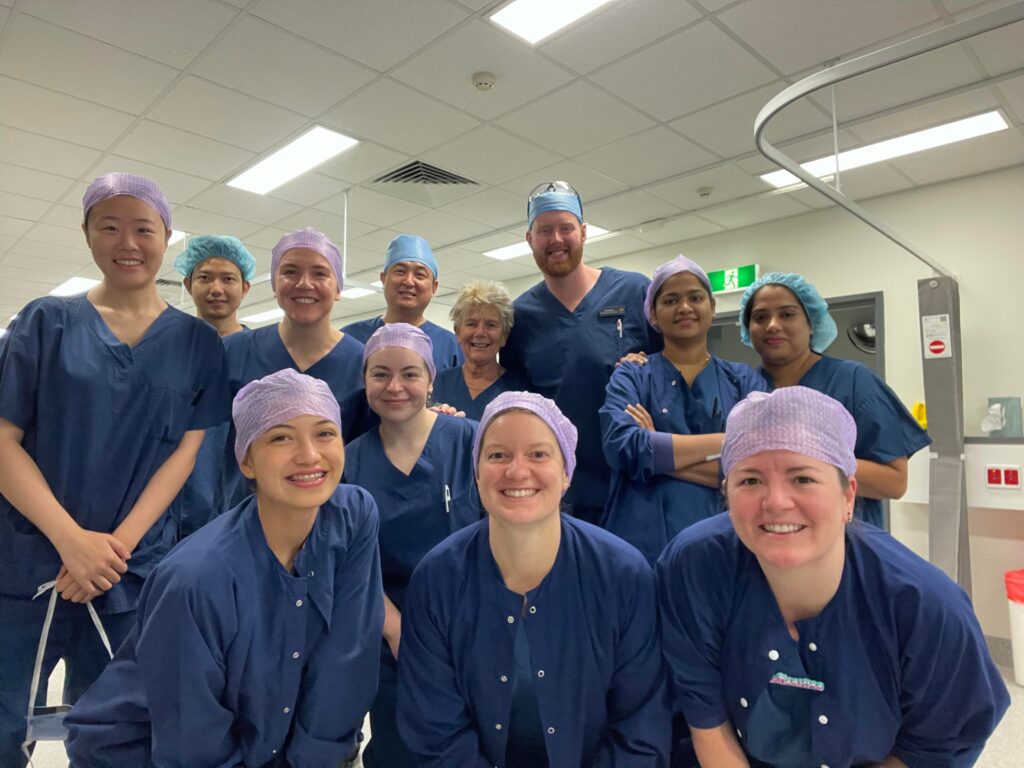Ankle arthritis is a condition where the cartilage surfaces that line the ankle joint become thin and eventually wear out completely. There are many causes of ankle arthritis including rheumatoid arthritis, long term result of traumatic injuries (fractures and dislocations of the ankle), recurrent instability due to ligament injuries, and angular deformity elsewhere in the leg. In many patients, however, there is no clear reason why arthritis develops, and this may be due to a genetic predisposition.
Normal cartilage allows the tibia (shin bone) and talus (ankle bone) to glide against one another. When this cartilage thins and disappears, this movement becomes painful. The body can sense this process and often attempts to grow extra bone around the joint (osteophytes), which makes the joint stiffer.
symptoms
Ankle arthritis causes a combination of stiffness, pain and grinding sensations. Paradoxically some people with severe arthritis on an x-ray may have only mild pain because their ankle is so stiff that the joint surfaces allow only very slight movement which results in less pain than somebody with more movement.
Pain resulting from ankle arthritis varies between different individuals and is influenced by a range of factors, including the cause of arthritis and areas affected within the foot and ankle. Pain is often more bearable in the morning and worse towards the end of a busy day. Night time pain is typically an indicator of severe arthritis. Patients with rheumatoid arthritis however often describe the opposite, whereby pain and stiffness are worst first thing in the morning and they gradually “warm up” through the day.
non-operative treatment
For most people with ankle arthritis, non-operative management is appropriate in the first instance. A multi-modal approach can be very effective at reducing troubling symptoms and avoiding the need for surgery.
A comprehensive approach to ankle arthritis includes:
- Lifestyle modification
- Avoiding “high impact” type activities including running and jumping.
- Participating in “low impact” type activities including cycling, swimming, walking.
- In overweight people, weight reduction can significantly improve symptoms.
- Pain medication
- A combination of regular paracetamol and intermittent non-steroidal anti-inflammatories (NSAIDs, such as Nurofen, Celebrex, Mobic) can provide good pain control in many patients with ankle arthritis.
- Where you have been diagnosed with neuropathic (nerve) pain in addition to arthritis, nerve-specific medication such as gabapentin or pregabalin may be beneficial.
- Opiate and similar pain medication (Oxycodone, Endone, Oxycontin, Tramadol, Palexia) can be effective in the short term but are rarely effective in managing long term pain.
- There are a number of pain medication options which can provide good pain control, however the use of these needs to be weighed up with potential side effects and interactions with other medications you may be taking and other medical conditions. All medications carry risks and side effects, and you should discuss these with your local doctor, sports doctor or surgeon before commencing.
- Splints, braces, orthotics
- In some people a splint or brace that reduces movement may reduce pain.
- Corticosteroid Injections
- Corticosteroid (Cortisone) injections into the ankle joint can be effective in relieving pain from arthritis for a short period (several weeks up to six months). Repeated injections tend to be less and less effective.
- These are most useful for people not yet ready for surgery, for example they have an upcoming holiday or trip planned and want to reduce their pain for the next few months.
- Physiotherapy
- Physiotherapy can be beneficial in people with recurrent ankle instability causing joint damage. Retraining of the muscles that stabilise the ankle can help slow the progression of arthritis.
operative treatment
In people with severe pain not controlled by the above measures, surgery can be considered. The three main surgical options include:
- Ankle arthroscopy and debridement,
- Total ankle replacement, and
- Ankle fusion
arthroscopy and debridement
A camera is inserted into the ankle joint allowing direct inspection of the damage to the cartilage surfaces. Small unstable flaps of cartilage that cause pain can be trimmed away, and some painful bone outgrowths (osteophytes) can be shaved away.
This procedure can be effective in relieving some pain however is unlikely to alter the overall progression of arthritis. In people with mild severity of arthritis however it can be useful for keeping symptoms at bay. Removing bony growths (osteophytes) can make the ankle joint more mobile, which in most people will be beneficial but in a small number there is a risk of their pain getting worse.
total ankle replacement
Total ankle replacement is a continually advancing surgical technique for the treatment of severe ankle arthritis. It is effective in relieving pain while preserving ankle movement. By preserving ankle movement, the ankle feels more “normal”, and patients often find walking, particularly climbing stairs and inclines, easier and more comfortable.
The procedure involves removing a small portion of the tibia (shin) and talus (ankle) bones. In the space created by removing this bone, metallic components are inserted, and a plastic liner between them allows smooth gliding movement. In principle, this is like replacement of a hip, knee, or shoulder joint. The normal anatomy of these joints and therefore their joint replacements are very distinctly different.
Total ankle replacements have existed for many years. In the past, the implants have not been as advanced or reliable when compared to hip and knee replacements. This has changed in recent years with improved implant design, and the availability of patient-specific instrumentation (PSI) which enhances the surgeon’s ability to accurately position the components.
The number of total ankle replacements performed in Australia increased 135% between 2015 and 2020 due to advances in implants and surgical technique1.
The use of patient specific instrumentation (PSI) allows a surgeon to position the implants of a total ankle replacement more accurately based on your own limb alignment. This involves a pre-operative CT scan which is sent to a team of engineers. The engineers analyse your ankle to determine the exact alignment and send a plan back to the surgeon. This plan is reviewed and approved by your surgeon, after which customised cutting guides which match only your ankle will be 3D printed. These cutting guides are then sterilised and used in your operation to ensure that the bone cuts made match exactly to those in the pre-operative plan. In addition to aiding the accuracy of cuts, this also greatly reduces the time needed to perform the operation which reduces other risks of surgery as well.
One downside of total ankle replacement is the potential need for future revision surgery or a “re-do” procedure. In the early stages this may be due to infection, and longer term can be due to wearing out of the implants or the plastic liner between them. Australia-wide data has demonstrated that 12 years after a total ankle replacement for osteoarthritis, 83% of patients continue to have a functioning prosthesis without the need for revision surgery1. Of these revision procedures, 50% are purely to exchange to plastic liner that sits between the metal components1, which is a minor procedure with a quick recovery time. The advancements in implant design and technology show significantly better performance with modern implants. In ankle replacements performed prior to 2015, 11% required a revision procedure after 5 years. However, since 2015 this rate has almost halved to 6% after 5 years1.
Historically, a revision could only be performed by conversion to an ankle fusion, which is technically challenging due to the gap between the bones left behind are removing the ankle replacement implants. Modern technology however now makes it possible to remove a total ankle replacement and replace it with new implants.
ankle fusion
Ankle fusion, or arthrodesis, is a well-established and effective treatment for severe ankle arthritis. A successful ankle fusion will result in significantly reduced pain while typically maintaining a high level of function, but at the cost of eliminating any movement at the ankle joint.
The procedure involves removing any remaining cartilage surfaces from the tibia (shin) and talus (ankle) bones as well as a thin slice of bone immediately underneath the cartilage (subchondral bone). The two bone ends are compressed together and held with a combination of plates and screws. If necessary, bone graft (taken from your own body, another person’s body donated to the bone bank, or synthetic) may be placed between the bones to encourage healing.
Although after a successful fusion there is no longer any movement at the ankle joint itself, the other surrounding joints can compensate to a small degree. People with an ankle fusion and no arthritis in other joints of the hindfoot and midfoot can expect 10-15° of apparent ankle movement. This extra movement does however place additional stress on these joints, particularly the talonavicular joint. Over 50% of patients have talonavicular arthritis and 90% have subtalar (between talus and calcaneus) arthritis at long term follow up2. While these smaller joints can also be fused successfully to relieve pain, this reduces movement further and further.
In people with severe arthritis that requires a definitive operation, the choice between ankle fusion and ankle replacement is largely a personal one. Total ankle replacement has very high patient satisfaction due to relief of pain and preservation of movement, however heavy activities such as running and jumping are not advisable. Ankle fusion is very effective at relieving pain at the expense of movement. Once a fusion has completely healed however, it is solid enough to withstand forces required for heavier activities, however these may be difficult to perform in practice due to the reduced movement possible.
conversion of ankle fusion to ankle replacement
A small number of people, particularly younger people, with an ankle fusion wish to regain some movement in their ankle. Conversion or “takedown” of an ankle fusion to an ankle replacement is now possible in some people due to improvements in implant technology.
contact
This fact sheet is a brief overview of ankle arthritis, produced by our Foot and Ankle Surgeon Dr Thomas Fisher. To make an appointment or enquiry with Dr Fisher or a member of our foot and ankle team, contact 08 8362 7788 or email ortho@sportsmed.com.au.
References
1. AOANJRR. Demographics and Outcome of Ankle Arthroplasty 2021 [Internet]. Australian Orthopaedic Association National Joint Replacement Registry; 2021. Available from: https://aoanjrr.sahmri.com/documents/10180/712294/2021+Demographics+Outcome+Ankle+Arthroplasty+SR
2. Coester LM, Saltzman CL, Leupold J, Pontarelli W. Long-Term Results Following Ankle Arthrodesis for Post-Traumatic Arthritis. J Bone Jt Surgery-american Volume. 2001;83(2):219–28.



